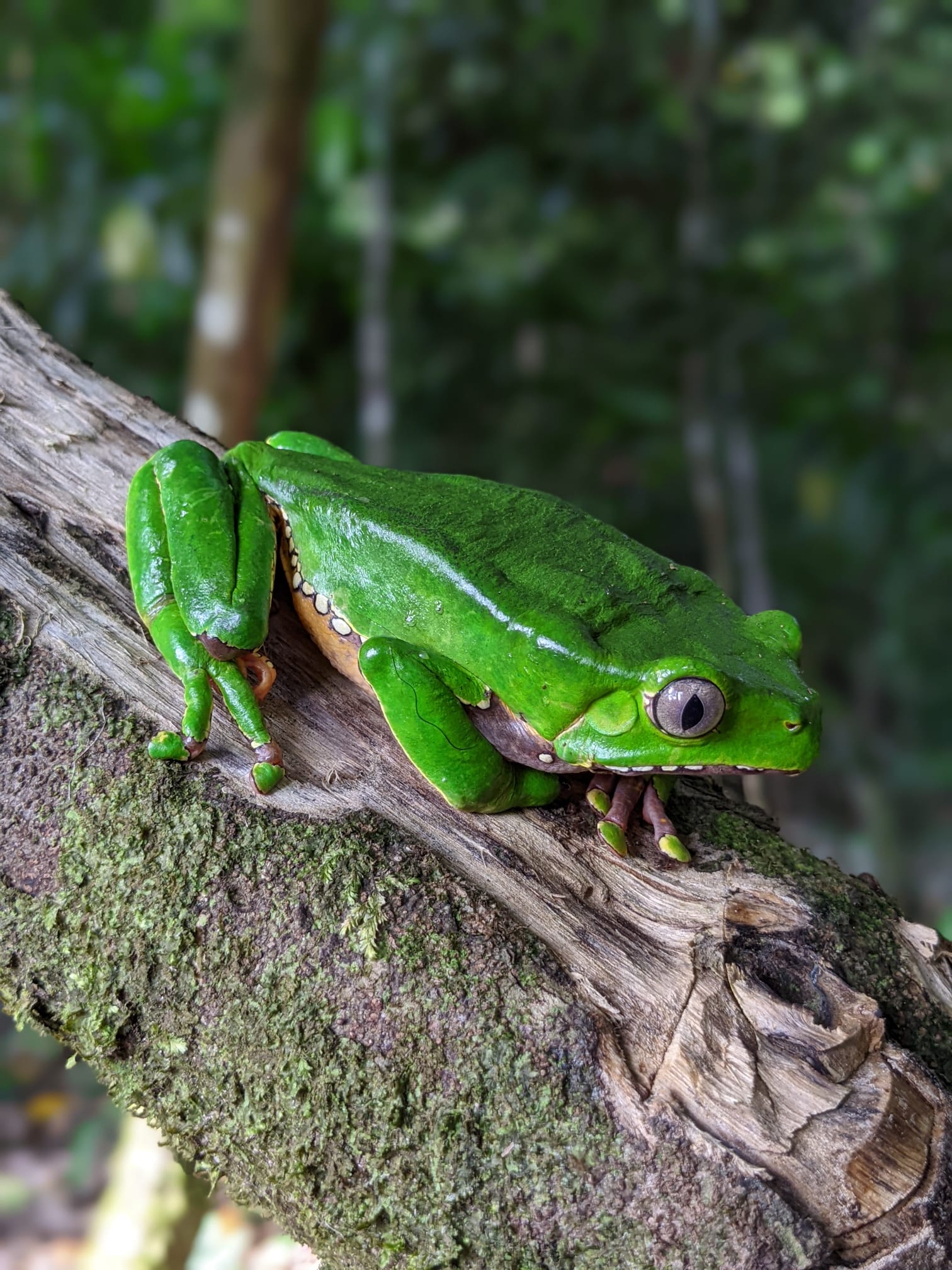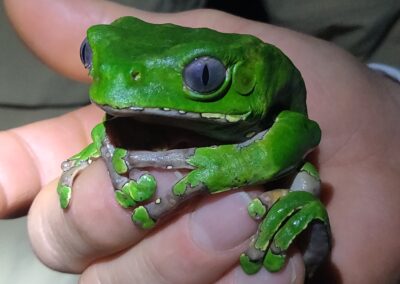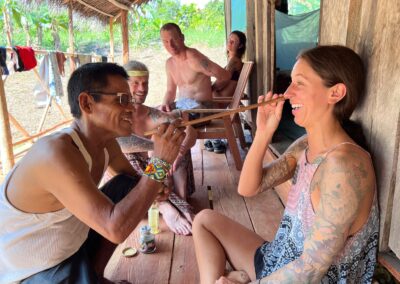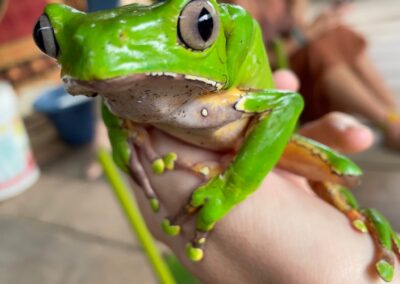ABOUT KAMBO

Kambo: The supreme ally in heart centered living
With many brilliant gifts awaiting, Kambo calls to those who are ready for its teachings. Think of Kambo as a wise guide by your side, while you ask the questions “What’s no longer working in my life- what am I ready to let go of?” and “What and I ready to create beyond my wildest imagination?” If you’re willing to ask, and are open to receiving, Kambo is happy to offer its suggestions.
The frog has no predators due to its skin coating. Being able to move through life freely, without fear, is one of the protective qualities we may embrace when connecting with Kambo. Well known for the green light that it emits throughout your energy field, this high vibrational light attracts that which holds the same high vibration.
An intelligent spirit, Kambo is able to align with your inner guidance and pinpoint what needs to be worked on first. As your relationship with Kambo continues to grow, so do the depths and layers you’re able to work on together.
While it’s easy for us to become comfortable in the routines of daily life, there are times when it can be helpful to explore what lies beyond our everyday patterns. Through that exploration, we are able to find our way into greater flow, health, and synchronicity.
Kambo is a step in the direction of radical self care, creating space for us to nurture the parts of us in need. We all deserve the ability to create the impact in the world we’re meant to have.
Traditional use of Kambô
Kambo grants us its many gifts to help us in a myriad of ways.
Kambo is one of the largest Hylid frogs known as the Giant Green Monkey Tree Frog. Its secretion is not a sweat nor a poison in the sense that it alone is not capable of causing death or illness. In the Amazon, it is regarded as a medicine. However this should not be confused with the western definition of a medicine. Kambo is not a medicine and those that administer it are not doctors and do not diagnose illness.
Native to the Amazon jungle of South America, the frogs habitat is mainly in Peru, Brazil, and Columbia. Like monkeys, they’re able to grab and climb through the trees extremely well due to their opposable thumbs. Behind both of its eyes lie glands that create a waxy secretion. The frog uses its legs to wipe the secretion all over its body to protect the skin. Being nocturnal, the frog spends the daytime perched high in the treetops. The Giant Waxy Frog is one of the few species able to withstand intense sunlight and not dry out, due to its protective coating.
The hot, humid environment of the rainforest is a prime atmosphere for the growth of many bacteria and fungi. Natures intelligence has allowed for the skin of the frog to produce a complex mixture of many bioactive compounds to protect themselves from bacteria, fungi, and predators. From such harsh environments come the most resilient creatures and chemical makeups.
There are several tribes are well known for working with Kambo, and they include the Katukina, Kaxinawá, Yawanawá, Matsés, and Mayoruna. The Matsés have a different name for the frog- they call it Acaté, and they prefer that we use this name.
The members of the tribe will either listen to hear where the frog is, or mimic its call to have the frog respond. Once the frog has been located, they carefully take it out of the tree and place it in a container in order to carry it home.
When the Kambo is ready for harvesting, each of the frogs wrists and ankles are tied with string. The legs are then stretched and tied to stakes, creating an X shape with the body. The secretion is then carefully scraped off the body and dried on small flat sticks. The frogs are treated with care, although the process can be uncomfortable for them. Once the secretions have been collected, the frog is then placed back in a tree.
The secretion is dried and kept on small flat sticks. When they’re ready for use, drops of water or saliva are added to the stick. Scraping gently with a knife helps to reconstitute the secretion into a tapioca-like consistency. After being adequately mixed, the secretion is then formed into the dots that will be placed on the body. Small points are made on the skin by using a glowing-hot piece of vine to blister the top layer of skin. The thin layer of skin is then wiped off. The dots are then placed on the open points. The effects are felt quickly!
Modern use of Kambô
Outside of the forest, Kambo has been the subject of nearly three decades of medical research. The first observations of Kambo use were made by a French priest, Father Constantin Tastevin in 1925 whilst he was staying with the Kaxinawá tribe in the upper Juruá River in Brazil. In the 1980’s an American Anthropologist, Katherine Milton described Kambo use among the Mayoruna tribe in Brazil. In the 1980s Peter Gorman wrote about his experiences taking Kambo with the Matses tribe in Peru.
During the 1990’s, rubber tappers in Brazil learned about Kambo from the Amazon Indians. They began to take it out into the towns of Acre and apply it themselves. Having spent several years living with the Katukina, Francisco Gomes from Cruzeiro do Sol was one of the first people to pioneer the use of Kambo outside the Amazon. The practice spread and soon people in the larger cities of Brazil began using Kambo.
An Italian scientist, Vittorio Erspamer of the University of Rome, was the first person to analyze Kambo in a laboratory. In 1986, he wrote that it contains a “fantastic chemical cocktail with potential medical applications, unequalled by any other amphibian”. The chemicals he referred to are peptides, some of which include bradykinins (phyllokinin), tachykinins (phyllomedusin), caerulein, sauvagine, tryptophyllins, dermorphins, deltorphins and bombesins. The peptides studied by Erspamer have become essential to characterize the functional role of opioid receptors. He was twice nominated for a Nobel Prize and was also the person who first discovered serotonin. Several peptides have since been isolated from the secretion and several have been synthesized. Currently there are over 70 Kambo patents lodged, mainly in the USA. Kambo is legal almost everywhere in the world with few exceptions.
Information courtesy of Kambo International
For further reading and research, please check out the following websites:
12 things to know about Kambo before your session
Video of a woman and her Kambo experience
Video of Kambo frog applying “suncream” (protective coating)
Kambo International- Links to research papers and articles
Screening your practitioner
It is very important for you to screen potential facilitators for your ceremony- your health and safety are in the hands of another person! Ceremonies have become more popular, and this influx has brought with it some inexperienced, careless people offering sessions.
A good practitioner will be transparent, educate you, take the time to answer all the questions you may have, and create a sense of safety and comfort. They will also know the limits of their experience level.
A guideline of questions to ask:
-Do they book an initial consultation, to connect before a session?
This would be when you can have all your questions answered. They must also go over your health background, to make sure you can attend a session safely. Your safety is the number one priority.. if they don’t screen your health, walk away.
-When did they begin practicing on clients?
Who did they study under- organization, mentor, apprenticeship? Names of teachers?
How many clients have they had? What’s their safety record? Any incidents?
-What’s the ceremony space like?
Is it outdoors, in a home, business, studio? Parking? Stairs? How many bathrooms? What should you bring?
How many people can attend a group session? How much space does each person have? Are there assistants?
What time does everyone arrive? When can you leave?
Are you able to rest afterwards, or does everyone have to leave the space by a certain time? Are you able to stay after the session closes if you’re still processing?
Is the space clean, and the practitioners tools/supplies clean and in good order?
-What are the water guidelines?
Do they tell you to limit your liquids before arriving? How much do you drink before/during/after?
A session shouldn’t exceed 3 liters- anything beyond that runs the risk of hyponatremia.
-How would a first timers session go?
Do they say they’ll start with a test point (one point) to check for any reactions before continuing?
How many points would you receive during a session?
-Do they say that either they or an assistant must walk you to the bathroom during a session?
Most accidents happen when standing up and then fainting, due to the blood pressure fluctuation.
-How is a session run?
Is it ritualistic, or clinical? Is there a doctrine that the practitioner holds and practices in a session? Religious element? Ideologies?
What should you bring? Can you bring items for the alter?
Is talking allowed during? Silence?
-Where are the sticks from?
Who gathers it? How is it harvested? How are the frogs cared for?
-How is my information kept confidential?
Please note that this work is not for you if you have, or have had, any of the following:
-TIA
-Stroke
-Aneurism
-Brain hemorrhage
-Serious heart problems (heart bypass surgery, enlarged heart, implanted cardioverter defibrillators, pericardial effusion, congestive heart disease, excess fluid in the heart sack, heart valve replacement surgery)
-Epilepsy
-Addisons disease
-Unable to withstand exercise that increases the heart rate
-Organ transplant (taking immune suppressants for organ transplant)
-Low blood pressure that requires medication
-Recovering from surgery
-Serious mental health conditions (excluding depression, PTSD, and anxiety)
-Undergoing chemotherapy/radiation
-Women who are pregnant, or may possibly be pregnant
-Women who are breastfeeding a baby under 6 months old
-You lack the mental capacity to make the choice to take Kambo on your own
-You are under 18 years of age
-You have worked with Bufo Alvarius (toad medicine) within the past 6-8 weeks
Always disclose the following to your practitioner:
-Asthma
-Fasting
-Allergies
-Diabetes
-Medications
-Supplements
-Recreational drugs
-Liver or kidney problems
-High or low blood pressure
-History of bulimia or anorexia
-Exercise (types and frequency)
-Previous mental health diagnosis’s
-History of drug/alcohol dependency
-Previous work with other plant medicines
-Existing, chronic, or previous health issues
-Medications you’ve recently stopped taking
-Current or previous use of diet/slimming pills
-Current or previous use of sleeping pills/supplements
-Current or previous viral conditions (lyme, hepatitis, dengue, etc)
Meeting the frog
Once your commitment has been made, your reality may begin to shift to accommodate your upcoming transformation. Some have commented on having been able to feel the effects a few days before their actual ceremony date! This is totally (or toad-ally?) normal!
You’ll arrive to a space that has been saged/smudged. Prayers or intentions will be used to create the sacred container for you to do your work in.
Sananga eyedrops may be offered as well. They help to ground you into your body, clear the mind, aid in the removal of Panema (heavy, dense energies). It’s important to note that the sensation is intense (like getting jalapeño in your eye!) The intensity lasts for a minute or so; during this time you’ll keep your eyes closed while breathing slowly and deeply, and may enter a relaxed meditative state.
When you are ready, you will begin your communion with the frog.
For safety purposes a single test point will be used. From there your response and sensitivity will be assessed, and you may have more points added.
Kambo is non-psychoactive, and its effects are generally physical in nature. Your experience will be different each time.
Some people have felt:
Rapid heartbeat, feeling hot or cold, tingling, sweating, shaking, crying, feeling lightheaded, headache, facial swelling (becoming “frog faced”), dry/swollen throat, discomfort, nausea, vomiting, and diarrhea.
Throughout your experience it helps to breathe slowly and deeply into your belly while sitting straight up- this creates a straight channel for the energy to flow through easily.
The strong effects are usually pretty short, lasting 20-40 minutes. The points are left on for a minimum of 20 minutes, allowing froggy the time to go deep within and work wherever it needs to be.
After the points have been wiped off your skin, some people like to lay down and rest for a bit. Sangre de Grado (or dragon’s blood, a sap from the Amazonian jungle tree Croton Lechleri) will then be put on your skin. This seals and protects the skin while it heals. From here it’s important to not put anything else on the points (lotions, oils, aloe vera, etc) as they need to be able to “breathe” in order to heal properly. The dragon’s blood falls off on its own, usually after a week or so.
After resting for awhile, you’ll have a cup of tea with honey.
It’s recommended to be gentle with yourself in the days following your experience, since you may be more sensitive. It’s good to set aside time with yourself to receive any messages or insights. Spending quiet time with yourself in nature, going for walks, journaling, taking baths, doing Qigong, going to sound healings, doing yoga, dancing, getting a massage, meditating and such can be helpful in your integration.
Emotions or memories from the past can surface, which can sometimes be challenging. This can happen before, during or after your session, and is quite normal if it does. It’s recommended to have friends, loved ones, coaches, and counselors to help support you in your integration.
Links for counselor/therapist support:
Open Path sliding scale counseling
Psychedelic.Support Chicago
Shamanic Coaching
People sometimes ask how many sessions they should do, or how far to space them out. It’s always important to tune into yourself– you can get an intuitive sense of when it’s time to revisit your froggy companion! it’s also important to remember that each person has so many nuances and complexities that make them unique- meaning there is no “one size fits all” way of going about things.
It can be helpful in some instances to do 3 days in a row, or 3 times within a moon cycle. Generally, this is when a culmination of both the physical and energetic properties can help “push” a person through what they’re working on.
Each session builds upon the previous. I liken it to a relationship with a person- the more time you spend together, the more intimately you understand each other 🙂
Some people like to schedule a session before/after their Aya retreat. This can help clear the way beforehand, so that your intentions are solid, and she can get right to the deep work. Afterwards, a session can help ground and integrate your time with her.
*Please note that none of the services offered on this website constitute any form of medical practice. Kambo is not a medicine. Kambo International practitioners are not doctors nor any other form of medical practitioners. KI practitioners do not diagnose disease, offer health advice, treat physical or mental health issues, or prescribe medicines.
Kambo is a shamanic ritual and ceremony from the Amazon rainforest- it is not a medical treatment. Participants are advised to do their own research as to the potential benefits of taking Kambo. None are offered or implied here.
*The statements on this page are not intended to diagnose, treat, prevent, or cure any disease. The are intended for educational purposes and are not meant to replace the advice of a licensed healthcare practitioner.




